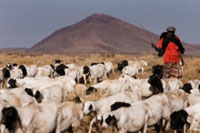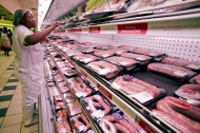



Towards a More Sustainable Livestock Sector
GLOBAL - Urgent investments, major agricultural research efforts and robust governance are required to ensure that the world's livestock sector responds to a growing demand for animal products and at the same time contributes to poverty reduction, food security, environmental sustainability and human health, FAO said today in a new edition of its flagship publication the State of Food and Agriculture (SOFA).
The report stresses that livestock is essential to the livelihoods of around one billion poor people. Livestock provides income, high-quality food, fuel, draught power, building material and fertilizer, thus contributing to food security and nutrition. For many small-scale farmers, livestock also provides an important safety net in times of need.
But the agency stressed the need for substantial investments and stronger institutions at global, regional, national and local levels, to ensure that continued growth of the livestock sector contributes to livelihoods, meets growing consumer demand and mitigates environmental and health concerns.


"The rapid transition of the livestock sector has been taking place in an institutional void," said FAO Director-General Jacques Diouf in the foreword of the report. "The issue of governance is central. Identifying and defining the appropriate role of government, in its broadest sense, is the cornerstone on which future development of the livestock sector must build."
Efforts are needed to ensure that this rapidly growing sector contributes fully to food security and poverty reduction, moving towards a ‘more responsible livestock sector', Mr Diouf said.
Driving force
The livestock sector is one of the fastest growing parts of the agricultural economy, the FAO report underlines. Livestock contributes 40 per cent of the global value of agricultural production and supports the livelihoods and food security of almost one billion people. Globally, livestock contributes 15 per cent of total food energy and 25 per cent of dietary protein. Products from livestock provide essential micronutrients that are not easily obtained from other plant food products.
Rising incomes, population growth and urbanization are the driving forces behind a growing demand for meat products in developing countries—and they will continue to be important. To meet rising demand, global annual meat production is expected to expand from 228 currently to 463 million tonnes by 2050 with the cattle population estimated to grow from 1.5 billion to 2.6 billion and that of goats and sheep from 1.7 billion to 2.7 billion, according to FAO estimates.
Livelihoods
Strong demand for animal food products offers significant opportunities for livestock to contribute to economic growth and poverty reduction. But many smallholders are facing several challenges in remaining competitive with larger, more intensive production systems. The report warns that "a widening gulf is emerging between those who can take advantage of growing demand for livestock products and those who cannot."
FAO recommends that smallholders should be supported in taking advantage of the opportunities provided by an expanding livestock sector and in managing the risks associated with increasing competition. Broader rural development strategies creating off-farm jobs should help those that may be unable to adapt and compete in a rapidly modernising sector. "Policy makers also need to recognize and protect livestock's safety-net function for the very poor," according to SOFA.
Environment
There is a need to enhance the efficiency of natural-resource use in the sector and to reduce the environmental footprint of livestock production, the report says. The goal is to ensure that continued growth in livestock production does not create undue pressure on ecosystems, biodiversity, land and forest resources and water quality and does not contribute to global warming. While some countries have made progress in reducing pollution and deforestation associated with livestock production, many more require appropriate policies and enforcement capacity. Market-based policies, such as taxes and fees for natural-resource use or payments for environmental services, would encourage producers to ensure that livestock production is carried out in a sustainable way.
Livestock can play an important role in both adapting to climate change and mitigating its effects on human welfare, FAO said. To realise the sector's potential to contribute to climate change mitigation and adaptation based on enhanced capacities to monitor, report and verify emissions from the livestock production new technologies will need to be developed.
Health
Animal diseases pose systemic risks that must be addressed, FAO said. Since new pathogenic agents will continue to emerge, investments in national animal-health and food safety infrastructure are required to reduce the risks of animal diseases to humans. Poor livestock keepers need to be more engaged in disease-control efforts.
Further Reading
| - | You can view FAO's State of Food and Agriculture (SOFA) by clicking here. |











